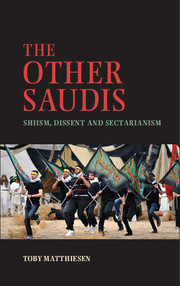Book contents
- Frontmatter
- Dedication
- Contents
- List of Maps and Pictures
- Acknowledgements
- A Note on Conventions
- Glossary
- Abbreviations
- Map
- Introduction
- 1 Politics of Notables
- 2 Oil and Dissent
- 3 Shia Islamism
- 4 A Decade of Confrontation
- 5 No More Revolution
- 6 Marginal Recognition
- 7 A New Intifada
- Conclusion The Politics of Sectarianism
- Bibliography
- Index
- References
Introduction
Published online by Cambridge University Press: 05 December 2014
- Frontmatter
- Dedication
- Contents
- List of Maps and Pictures
- Acknowledgements
- A Note on Conventions
- Glossary
- Abbreviations
- Map
- Introduction
- 1 Politics of Notables
- 2 Oil and Dissent
- 3 Shia Islamism
- 4 A Decade of Confrontation
- 5 No More Revolution
- 6 Marginal Recognition
- 7 A New Intifada
- Conclusion The Politics of Sectarianism
- Bibliography
- Index
- References
Summary
The stigmatisation of Shia Muslims as Saudi Arabia’s internal Other fulfills an important function in Saudi religious nationalism. At times of crisis the ‘Shia threat’ is used to rally the rest of the population, most of whom are Sunnis of different persuasions, around the ruling family. Shia in Saudi Arabia are confronted with a religious establishment that promotes the Wahhabi interpretation of Islam, the religious police, and a state apparatus from which they are often barred. Yet, when they travel abroad they are doing so on a Saudi passport, and are often confronted with the same stereotypes that people all over the world have of “the Saudis”. Indeed, they are an important if often misunderstood factor in Saudi domestic and regional policies. And their history in the country that is home to the two holy places of Islam – Mecca and Medina – is relevant to Muslims beyond Saudi Arabia’s borders. Shia Muslims all over the world are interested in the fate of their co-religionists in the Kingdom. Some Sunni Muslims, on the other hand, particularly those with salafi and anti-Shia leanings, consider their mere existence, and any political claims by Saudi Shia, to be anathema. Together with the fact that Shia live on top of some of Saudi Arabia’s largest oil fields, their history and political mobilisation, therefore, have ramifications far beyond Saudi Arabia.
In the Shadow of the Wahhabiyya
Saudi Arabia is often portrayed as a largely Hanbali- and Wahhabi-dominated country, but a variety of Islamic traditions and all four schools of Sunni religious law can be found across the country. The Eastern oasis of al-Ahsa has strong Maliki, Hanafi and Shafiʿi traditions. For most of modern Saudi history, these schools were largely excluded from official religious institutions. Only in 2009 were non-Wahhabi Sunni scholars appointed to the highest religious body, the Council of the Committee of Senior ʿUlamaʾ. Shia clerics have unsuccessfully demanded to be appointed to this body and have equally unsuccessfully pushed for the recognition of a higher body of Shia clerics.
- Type
- Chapter
- Information
- The Other SaudisShiism, Dissent and Sectarianism, pp. 1 - 23Publisher: Cambridge University PressPrint publication year: 2014



